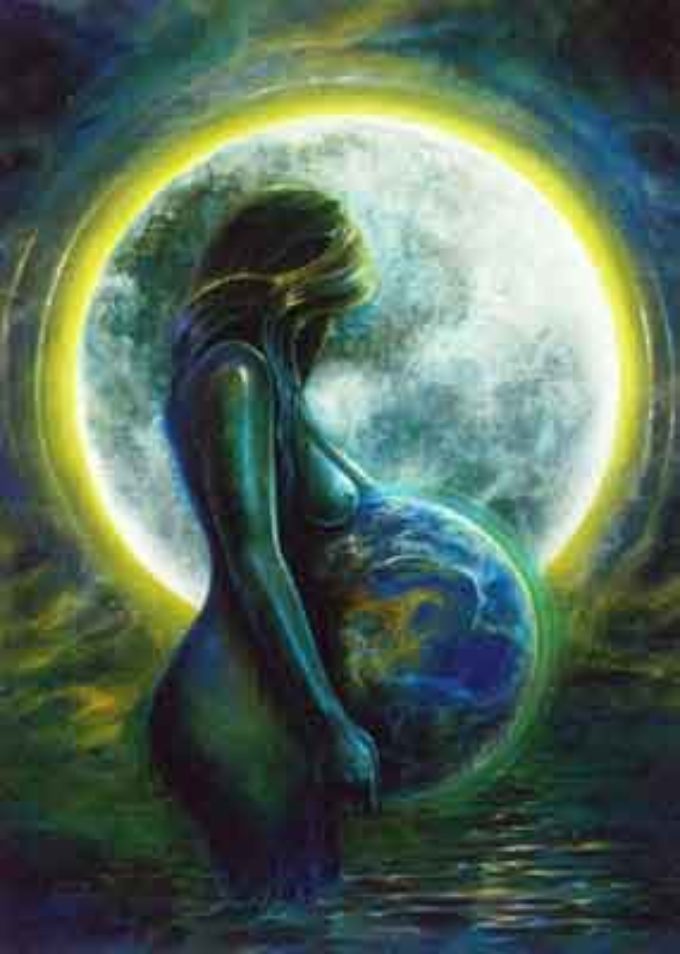
Often what is represented in nature also finds its correspondence in the conscience of man, in fact the creative act, whether ascribed to a God or to Mother Nature, has often been compared to that of an artist who produces his work.
This happens because in the Logos of the manifested world a design or a purpose is recognized and it is exactly what happens with the artistic production. But an essential difference could be noted, in fact in the case of artistic work, such as painting, there are many distinct causes. The material: the canvases, the color, etc. The formal: the configuration, etc. The efficient: the artist, the brush, etc. And the final: honoring someone, earning a living, etc. But in the case of the manifestation of the world there are no distinct causes, the original being only one, whether it is defined natural Energy or God.
"He painted the picture of the existent in himself and on himself, with the brush of his will, and he was immediately delighted" affirms an ancient Indian writing referring to the Creator. But even in other philosophical and scientific texts painting is often used as an example to signify the progressive carrying capacity of life.
Following the concept of the three successive stages of the cosmic manifestation, we observe that at the beginning there is the "latency" or "causal energy" then the "subtle" or "thought form" takes over and finally the "gross" or "matter". These stages are compared with 1) lightening of the canvases and strengthening them with starch; 2) the sketch of the contours of the figures on the canvas; 3) filling of images with color.
The "consciousness" or creative will is the coefficient cause of the work, which is like the bleached canvas; the operative "capacity" is the subtle cause, represented by the features that are barely sketched but present in the author's imagination, as the fetus is present in the maternal uterus; and finally the final form which is like the manifested birth or appearance and can be compared to the finished painting.
However, we must remember that these creative functions, in the case of the "creation of the universe", all belong to the same Force or expressive capacity. The artist, the material, the work, the critic, the client ... etc. they all originate from the same primordial Energy (or God).
"The image of name and form, the observer, the screen on which he sees, and the light for which he sees ... all these are Himself" Ramana Maharshi stated.
Paolo D'Arpini
Testo italiano
Spesso quel che è rappresentato nella natura trova anche una sua corrispondenza nella coscienza dell’uomo, infatti l’atto creativo, sia esso ascritto a un Dio od a Madre Natura, è stato spesso paragonato a quello di un artista che produce la sua opera.
Ciò avviene poiché nel Logos del mondo manifesto si riconosce un disegno od uno scopo ed è esattamente quel che avviene con la produzione artistica. Ma potrebbe essere notata una differenza essenziale, infatti nel caso del lavoro artistico, come ad esempio la pittura, vi sono molte cause distinte. La materiale: le tele, il colore, etc. La formale: la configurazione, etc. L’efficiente: l’artista, il pennello, etc. E la finale: l’onorare qualcuno, guadagnarsi da vivere, etc. Ma nel caso della manifestazione del mondo non vi sono cause distinte, essendo l’originale una sola, sia essa definita Energia naturale o Dio.
“Egli dipinse il quadro dell’esistente in se stesso e su se stesso, con il pennello della sua volontà, e fu subito lieto” Afferma una antica scrittura indiana riferendosi al Creatore. Ma anche in altri testi filosofici e scientifici spesso la pittura è usata come esempio per significare la progressiva capacità realizzatrice della vita.
Seguendo il concetto dei tre stadi successivi della manifestazione cosmica, osserviamo che all’inizio vi è la “latenza” o “energia causale” poi subentra il “sottile” o “forma pensiero” ed infine il “grossolano” o “materia”. Questi stadi vengono comparati con 1) lo schiarimento delle tele ed il rafforzarle con l’amido; 2) lo schizzo dei contorni delle figure sulla tela; 3) riempitura delle immagini con il colore.
La “coscienza” o volontà creatrice è la causa coefficiente dell’opera, che è come la tela sbiancata; la “capacità” operativa è la causa sottile, rappresentata dalle sembianze appena schizzate ma presenti nella fantasia dell’autore, come è presente il feto nell’utero materno; ed infine la forma finale che è come la nascita o apparizione manifesta e si può paragonare alla pittura finita.
Dobbiamo però ricordare che queste funzioni creatrici, nel caso della “creazione dell’universo” appartengono tutte alla medesima Forza o capacità espressiva. L’artista, il materiale, l’opera, il critico, il cliente.. etc. sono originati tutti dalla stessa Energia primordiale (o Dio).
“L’immagine di nome e forma, l’osservatore, lo schermo sul quale egli vede, e la luce per la quale egli vede… tutti questi sono Egli stesso” Affermava Ramana Maharshi.
Paolo D'Arpini


Nessun commento:
Posta un commento
Nota. Solo i membri di questo blog possono postare un commento.